Table of Contents
Digital transformation has become a buzzword in the business world and for good reason. The ongoing technological revolution that we are experiencing is equipping both organizations and people with ever-mightier tools and offerings, with the explosion of AI capabilities just being the latest example. Organizations that fail to adapt get left behind.
A successful digital transformation can help organizations improve efficiency, reduce costs, enhance customer experience, and create new value. Mind however that a digital transformation is never a one-time project with a finite end: it is an ongoing process. Having said that, most large organizations go for a major transformative change only every 8,5 years on average. So as you embark on a digital transformation, make plans for the day after tomorrow.
The road to digital transformation is however not an easy one: it requires a comprehensive and integrated approach across all domains, across numerous internal stakeholders, and involves more often than not numerous internal functions that need to be coordinated towards one end over a longer period of time.
In this blog article, we will focus on the strategic aspects of digital transformation and provide practical tips on how to start out on a digital transformation. We will discuss the importance of having a clear direction as a baseline, and only then taking action, by translating the direction into workstreams that are focused on its execution.
What is actually a digital transformation?
Digital transformation refers to the process of utilizing digital technologies to fundamentally change how organizations operate, create value, and interact with their customers, employees, and other stakeholders. More precisely, a digital transformation is a step-change to the existing business model and operating model of an organization. While most components of a business and operating model will remain the same, some aspects are fundamentally changed (the step-change). These transformative step-changes then typically lead to a number of follow-on changes and required adaptations in related areas, since all aspects of a business- and operating model are highly interconnected.
A digital transformation involves leveraging digital technologies, such as big data analytics, artificial intelligence, cloud computing, Internet of Things (IoT), blockchain, and others, to automate and streamline business processes, enhance customer experiences and enable new business models and revenue streams.
Digital transformation is not just about adopting new technologies; it also involves rethinking and redesigning business processes, organizational structures, and culture to align with the new digital reality. It requires a comprehensive and holistic approach that involves numerous stakeholders and functions of an organization.
The ultimate goal of digital transformation is to drive innovation, increase efficiency, improve agility, and create new value for customers and stakeholders. It is crucial for organizations to remain competitive, foster innovation, and navigate the evolving digital landscape successfully. At Digital Leadership, we emphasize the significance of digital transformation for businesses to thrive in the evolving economic landscape. We provide range of services includes Digital Transformation Solutions and Digital Transformation Consulting services. Through, our Solutions enable organizations to enhance digital capabilities, optimize operations, and transform business models. Through our Consulting service, we provide expert guidance to navigate the digital transformation journey and bridge the strategy-execution gap.
The following chart – the UNITE building blocks of digitalization – provides a high-level overview of the key aspects of Digital Transformation.
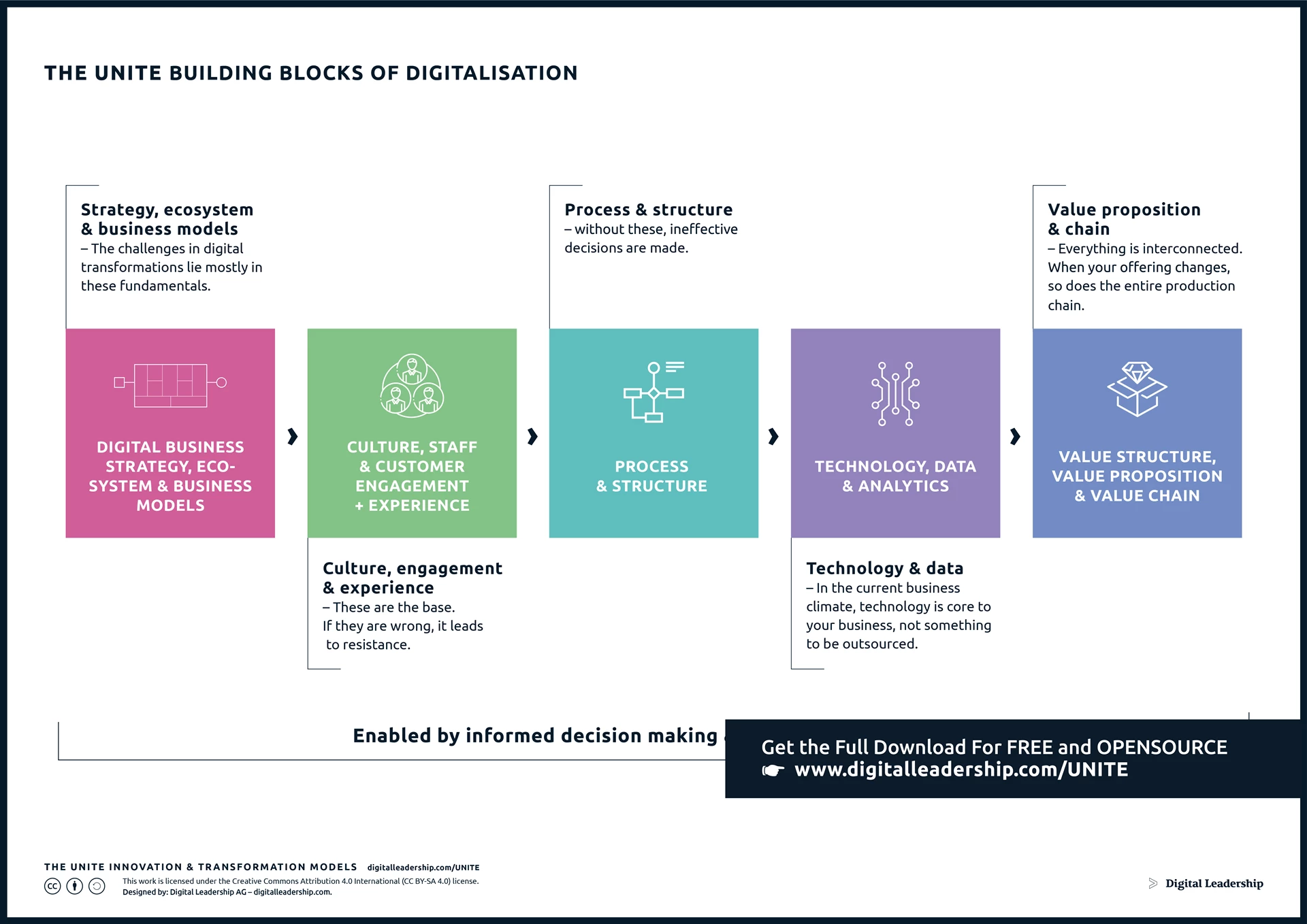
Designed by: Digital Leadership AG
So if we want to transform, you have to consider much broader picture than just technology: you have to also consider your business model and strategy, culture, processes and organizational structures as well as your value chains and value propositions.
Overall, a digital transformation touches upon many aspects of an organization, and it requires a comprehensive and integrated approach that involves all stakeholders and functions of the organization.
What do you actually want to be transforming?
When thinking about a digital transformation, organizations often have a way too narrow picture in mind what their (digital) transformation is supposed to look like. We find that most often, organizations just consider changing their digital channels or improving on their internal processes. While those aspects are potentially important parts of a digital transformation, we would like to invite you to think about a much broader picture!
Please consider the UNITE Business Model Canvas as a starting point: which aspects would you like to focus on as part of your digital transformation? Which aspects are likely to yield the best results, also taking into account the efforts involved to transforming those?

Designed by: Digital Leadership AG – Building on the work of Alexander Osterwalder
In the same context, also consider your operating model to greater depth: which aspects are you expecting to yield the best outcomes?
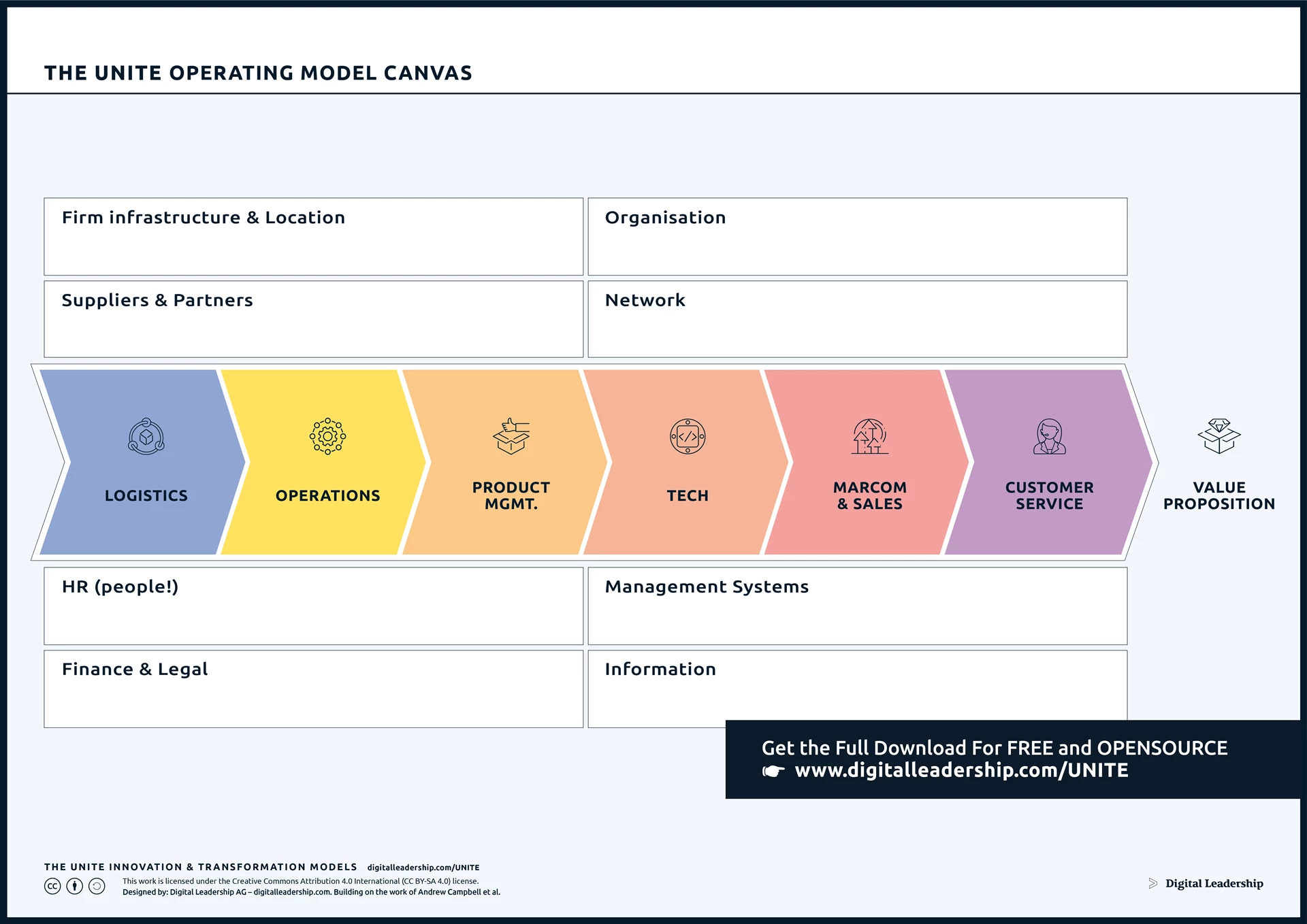
Designed by: Digital Leadership AG – Building on the work of Andrew Campbell at Al.
Importantly, when you work on your operating model and the related cost model, you are more likely to get more limited results. If you want to tackle a full-scale digital transformation, consider also your offering – the value and service model – as well as your experience model! These areas typically yield much greater potential.
What is your main strategic intention and objectives for your digital transformation?
We find that more often than not, organizations lack a precise strategic direction for their digital transformation and thus are lacking a definition of where they would like to be going.
This is one of the key problems we see on numerous transformative exercises, since without a clear direction, you will not get anywhere. So let’s clarify what a strategy is really all about.
What is a strategy to start with?
Strategy is often misunderstood, which is surprising because fundamentally it is a pretty basic concept. Strategy is a clearly expressed direction and a verified plan on how to get there.

Many strategies are really just ambitious goals, such as achieving market leadership in five years or being the go-to solution to such and such problem. However, as team members and customers increasingly seek to align themselves with organizations that resonate with their purpose and values, such lofty goals fall short of making sense to anyone (but perhaps shareholders). Organizations today need to go beyond growth ambitions and answer a deeper “why“.
Equally critical, organizations often fail to define how they will get there. Having a tested and confirmed plan for achieving your goal is essential and is required for any kind of credibility. Without clarity on how to make an organizational direction a reality, a strategy is not worth the paper it is written on.
A strategy, thus, summarizes a direction in terms of the organization’s broader purpose and provides a clear path or roadmap for how to achieve it. A well-explained strategy has a coordinating and federating effect on all members of the organization. It serves as a constant north star and feedback mechanism to determine whether the organization is on the right path and making progress toward its goal.
Define a clear business intention as a starting point
The first step in planning your transformation is to carefully consider what you as an organization are really after, in other words, your Business Intention. What problem do you want to solve? What legacy do you want to leave behind?
Your Business Intention (sometimes also called “motivation”) is a key directional decision that will define on the highest level what you are after. It is important to put it in writing. Often, we find that firms do not explicitly define their intention; this results in initiatives that do not match the original intention and are thus outside of the intended scope! Understanding the intention well is critical also from another perspective: fears motivate us seven times more strongly than hopes. This is why clearly defining a situation we want to avoid is a highly relevant exercise. Beyond this, a Business Intention is more pertinent than a bold vision, since it is precise and directive.
Your intention can take various shapes and will heavily influence your subsequent objectives, so be careful when choosing. If you are having trouble determining an intention, consider some of these options:

Designed by: Digital Leadership AG
How do you start a digital transformation?
At the highest level – on boardroom or executive leadership level – we suggest starting out by answering four key strategic questions which we call the „4 Strategic Perspectives “:
Considering these four aspects of strategy helps us shift the paradigm of our thinking. Innovations and digitalization initiatives are not limited to one process or part—rather we have to consider a much more holistic picture. If you stick to a more limited definition of digitalization, it may lead to a good deal of superficial change, but ultimately you will find yourself with little true transformation, and therefore a lack of lasting results.
Defining a clear direction for your digital transformation
What we ultimately need is a clearly articulated direction that is guiding our digital transformation that is detailing out the high-level direction.
To do so, we have to take two critical perspectives into account: what our customers want and what our business objectives are. Let’s discover how we identify both aspects!
(1) Defining your key user/customer benefits
Customers want to achieve certain goals. Do you know what these are in relationship to your products and services? And do you know how these will evolve over the next years?
To embark on a successful digital transformation journey, it is essential to understand those important but underserved customer needs . Collecting and understanding the benefits users are seeking to realize is a crucial input to a digital transformation, as it helps organizations to identify pain points, unmet needs, and opportunities for improvement. By listening to the voice of the user, organizations can develop a customer-centric digital transformation strategy that addresses their needs and creates value for them. If conducted well, this approach will lead to higher adoption rates, greater satisfaction, and increased loyalty among end users and customers at large. Furthermore, involving users in the digital transformation process can help to build a culture of innovation and collaboration, where stakeholders feel empowered to contribute to the success of the initiative. Therefore, collecting user benefits should be an integral part of any digital transformation strategy, as it can provide valuable insights and help organizations to achieve their business objectives.
To identify those needs, start with the data you have already available: you may have market research inputs, feedback on your website and products, collected customer insights and research on Moments of Truth. You can then enrich this picture with the expertise of subject matter experts (SMEs), innovation research, future trends and other inputs. In an ideal world, however, you would go beyond and really kick off a separate workstream that focuses on identifying those important but underserved customers’ needs in a quantifiable way. In the end this is what your digital transformation initiative in the end is based on and so your investment security depends on it(!). So we want to invite you to go out and identify those.
We at Digital Leadership are experts in identifying important but underserved customer needs with almost statistical certainty. We do so regularly for some of the world’s most exciting brands. Doing so is important since understanding your important but unmet customer needs ultimately increases your investment security drastically!
Get in touch with one of our Partners if you want to know more!
The following map provides an example of customer benefits that we have identified on a major global initiative.
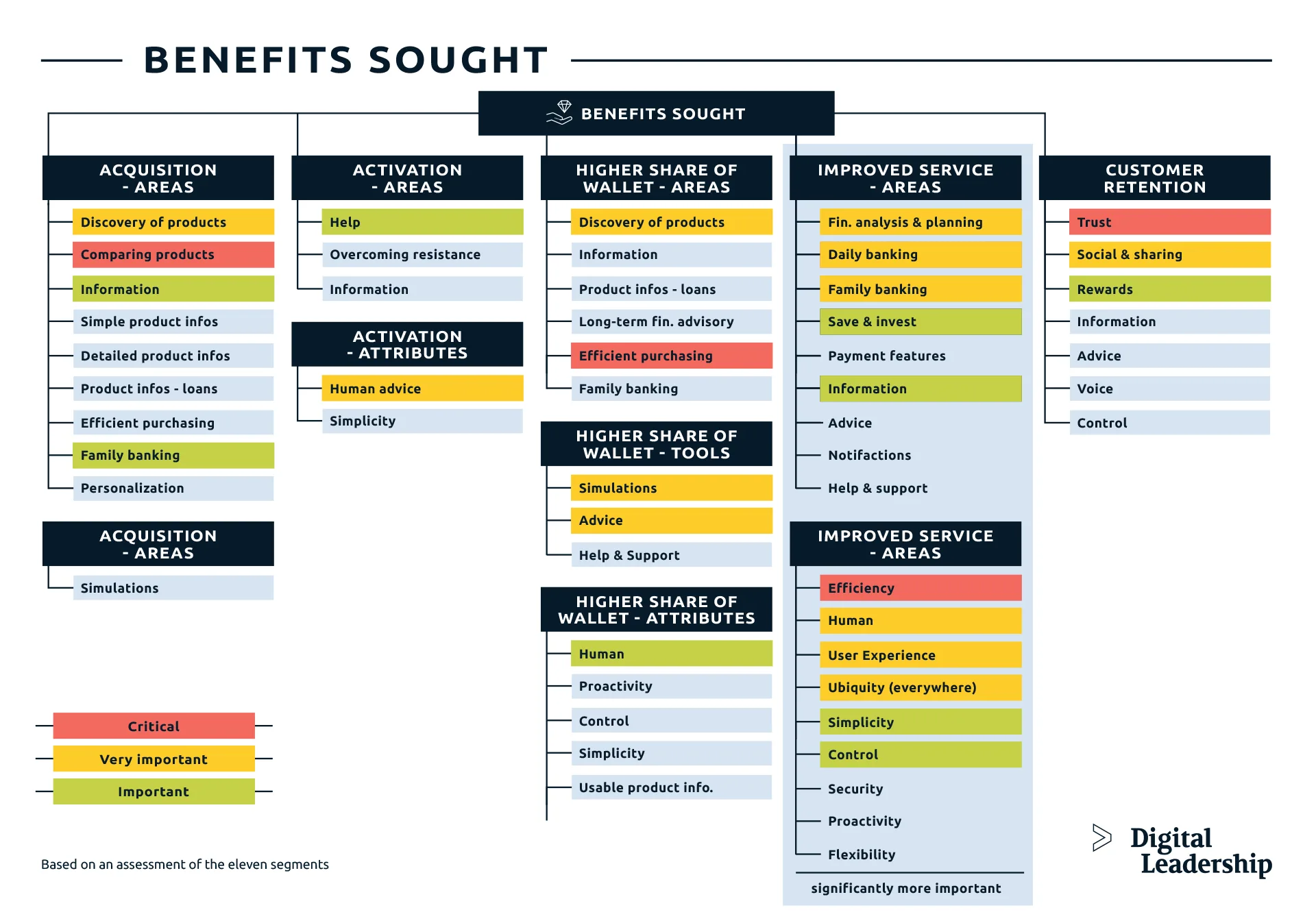
The user benefits are neatly broken down alongside the customer lifecycle. Importantly, everything in this example was quantitatively validated, this presentation just being a top-level abstract. So we really knew which objectives were critical, very important or just relevant.
(2) Defining your key business objectives
Understanding your business objectives is the other main critical input to define a digital transformation strategy. It is essential to align the digital transformation initiatives with the broader goals and objectives of the organization – so as an input to a digital transformation, take into account the overall strategy and priorities of the organization.
We often find however that organizations lack a well-documented strategy! They may have individual strategies for certain departments and a more or less well documented vision, but often an overall strategy is missing. What to do in those cases?
We suggest interviewing your most important stakeholders in those cases. These are typically C-suite individuals across all major departments involved in a digital transformation as well as their direct reports where required. In those interviews, we typically cover two horizons in an attempt to cover both the short-term objectives of their respective department (+3 years from now) and the longer-term objectives (+7 years) as well as what they are expecting from a digital transformation.
Here is a practical example from one of our projects:

(3) Defining the vision for your digital transformation
Defining a highly precise and compelling vision is a crucial step in developing a digital transformation strategy. A vision needs to summarize both user benefits and business objectives. Only when you have both key perspectives covered, will a vision statement resonate with both your customers / the end users as well as internal stakeholders.
The vision statement thus serves as a critical guidepost for all stakeholders involved in the digital transformation journey, providing clarity about the desired future state of the organization. This approach thus allows to build trust and credibility internally and externally and helps drive adoption and engagement among users, customers and internal stakeholders alike, ultimately leading to the required support and higher satisfaction.
The process equally ensures that the digital transformation initiative is aligned with the overall strategy of the organization. This alignment can also help to secure buy-in and support from management, making it easier to allocate resources and implement the digital transformation initiatives effectively.
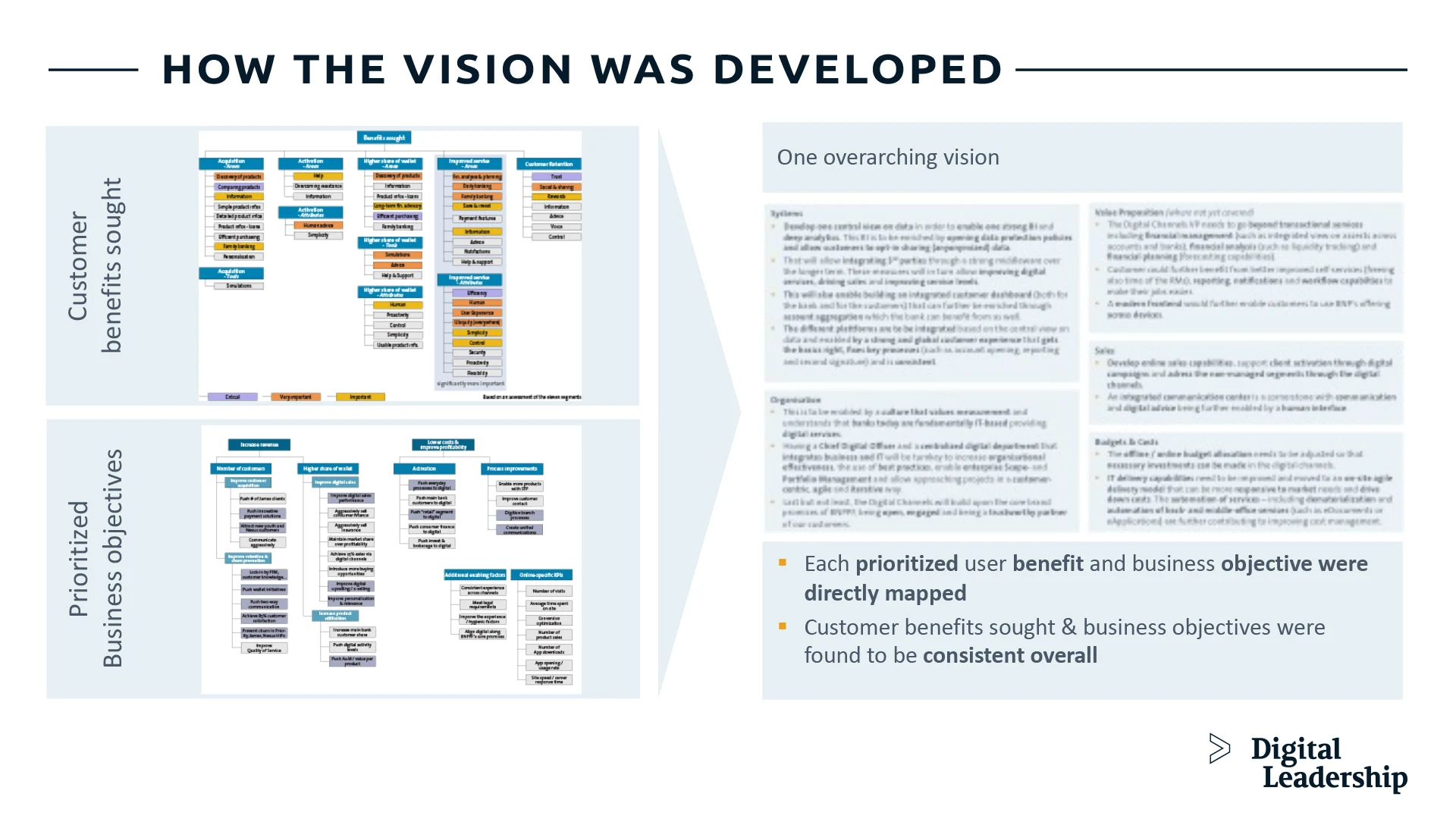
In summary, to develop a compelling vision for digital transformation, it is essential to consider both user benefits and business objectives. By doing so, organizations can develop a vision that is both customer-centric and aligned with the broader goals and objectives of the organization. This approach can help to ensure that digital transformation initiatives create value for the organization and its stakeholders and contribute to the long-term success of the organization.
Setting up the workstreams to execute on the defined direction
Once you have defined your key user benefits, and business objectives, and derived a vision from them, the next step is to set up workstreams that translate those into more detailed and actionable roadmaps, concrete requirements, and initiatives. The workstreams are ultimately there to translate a set of customer benefits and business objectives into reality. Typically they are organized around a specific theme or objective, such as customer experience, operations, or technology.
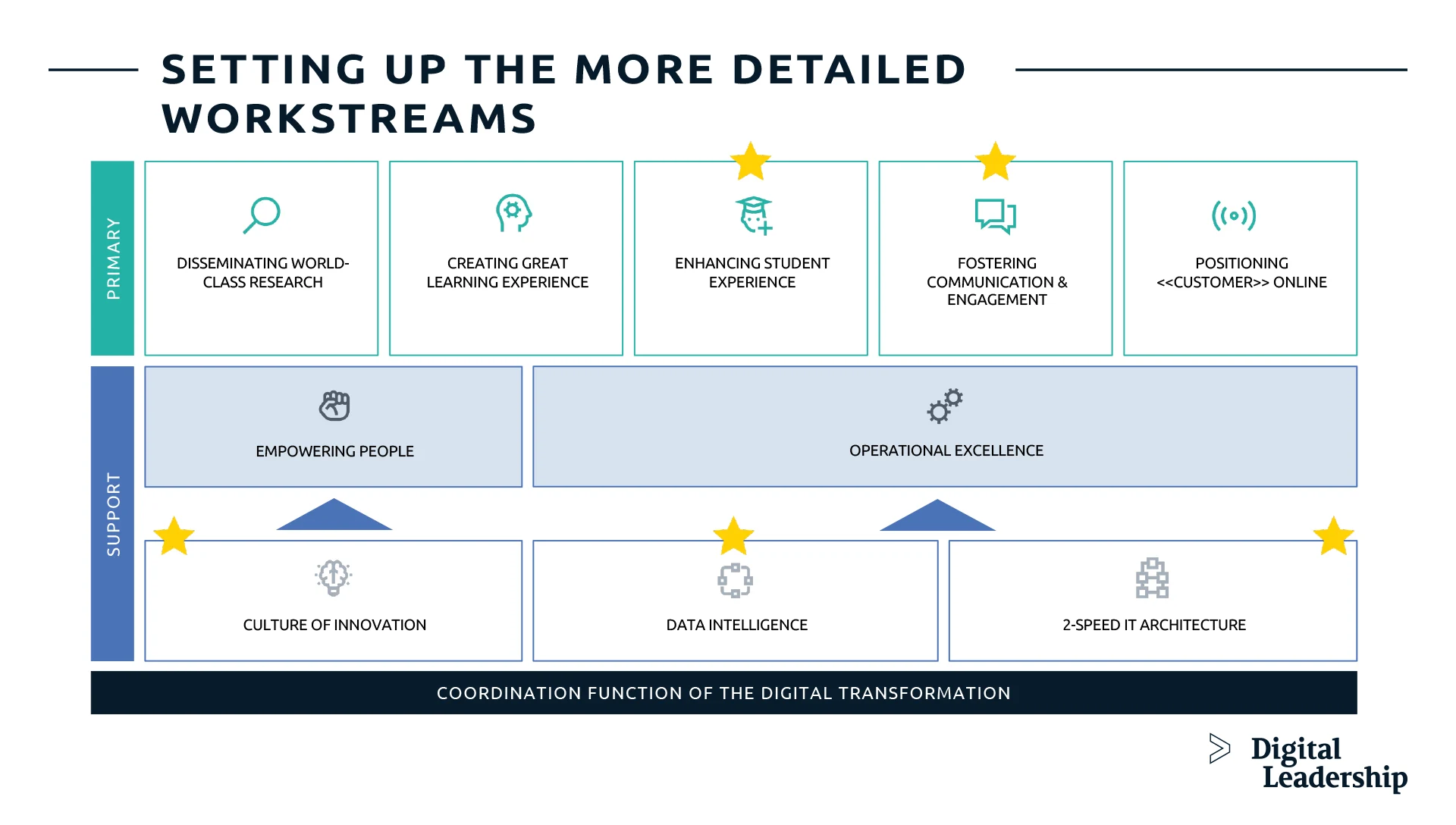
Each workstream should be led by a dedicated team of experts who have the skills and experience necessary to drive progress and achieve results. The team should include representatives from all relevant functions and departments, as well as external partners and vendors, as needed.
Developing a detailed roadmap by each workstream
Each workstream receives as an input the higher-level guiding inputs that were developed previously – the relevant part of the user benefits, business objectives and vision. These inputs serve as guideposts and guardrails for defining the digital transformation initiative further at the level of the workstream.
Each workstream now follows the exact same process as we discussed above:
- Identifying the user benefits on the level of the workstream
- Identifying the detailed business objectives on the level of the workstream
- Deriving a guiding vision on the level of the workstream
Once these items are defined in detail per workstream, each workstream then defines a detailed roadmap based on those. The roadmap is covering in depth the agenda for the next few months on a monthly basis, then quarterly, and then yearly basis for the next few years. As such, we do make sure we both have the details to govern the short-term, as well as have a shared understanding of the path ahead.
The roadmaps should include timelines, milestones, and dependencies to ensure that all initiatives are aligned and integrated with each other. Concrete requirements should be defined for each initiative, including functional, technical, and non-functional requirements, as well as success criteria and metrics for measuring progress and impact.
This process ensures that the initiative is fully aligned between the highest level customer and business objectives all the way down to the details of the execution per workstream.
By setting up workstreams that translate key user benefits, business objectives, and vision into detailed and actionable roadmaps, requirements, and initiatives, organizations can ensure that digital transformation initiatives are well-planned, executed, and aligned with their overall strategy. This approach ultimately leads to developing a value-maximizing roadmap of a digital transformation, thereby ensuring that the digital transformation directly contributes to the short-, mid-and long-term success of an organization.
Summary of results of phase I – “defining the direction” and kicking off the workstreams
In this article, we have discussed the importance of a strategic approach to digital transformation. We have highlighted the critical inputs required for a successful digital transformation strategy, including user benefits, business objectives, and a clear and compelling vision. We have also discussed the importance of setting up workstreams that translate the vision into detailed and actionable roadmaps, requirements, and initiatives.
In phase 1 of the digital transformation journey, we have emphasized the importance of identifying customer segmentation and prioritizing those segments, understanding the key benefits that those segments and users are seeking to achieve, defining business objectives, and deriving a vision from both user benefits and business objectives. We have then translated that vision into workstreams that focus on creating roadmaps bridging the as-is status in the to-be vision per area.
By taking a strategic approach and following these steps, organizations can develop a digital transformation strategy that is tailored to their unique needs and goals and that – most importantly – is setup in a value-maximizing way.

What we do at Digital Leadership to support a digital transformation
At Digital Leadership, we specialize in supporting organizations through their digital transformation journey. Our expertise lies in helping businesses define their digital transformation blueprint, which is a comprehensive strategy that outlines the necessary steps and actions required to transform their organization digitally.
Our approach to developing a digital transformation blueprint involves a thorough analysis of the organization’s current state, including its existing technology infrastructure, processes, and culture. We then work closely with our clients to identify their business objectives and key user benefits, which help inform the vision for the digital transformation.
Once the vision is established, we break down the transformation into actionable workstreams, each with its own roadmap, backlog, and scope. Our experienced team members work closely with our clients as true partners to ensure that each workstream is aligned with the overall vision and objectives, and that progress is made in a steady way, avoiding the usual “zig-zag” organizations often face.
Throughout the process, we provide our clients with access to our proven digital transformation methodology, tools, and templates, as well as support in project and program management, change management, and stakeholder management. Our goal is to ensure that our clients not only achieve their digital transformation objectives but also become self-sufficient in their digital capabilities and are able to sustain long-term success in the digital age.
































 Book How to Create Innovation
Book How to Create Innovation